Dinosaur Hall
 Dinosaur Hall
Dinosaur Hall
It’s one of the first things visitors see when they enter the Academy of Natural Sciences: measuring up to 42 feet in length and weighing in at an estimated 7.5 tons, Tyrannosaurus rex was one of the largest predators to ever walk the Earth.
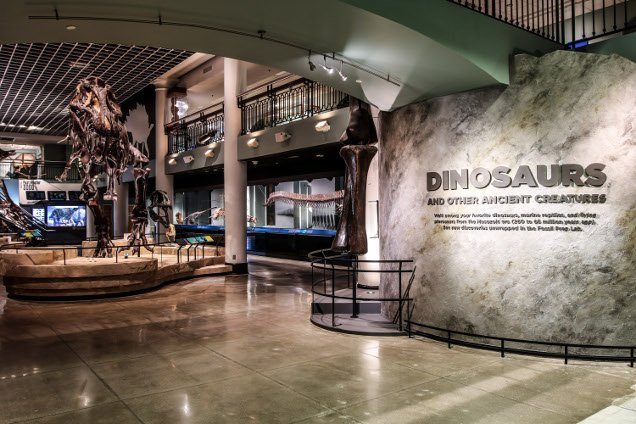
This impressive animal is one of many dinosaurs and other Mesozoic creatures you’ll encounter in Dinosaur Hall. More than 30 species are represented, about half of which are full skeletal mounts, including Avaceratops, Chasmosaurus, Corythosaurus, Deinonychus, Pachycephalosaurus, Tenontosaurus, and Tylosaurus.
In addition to the skeletons, visitors can view dinosaur eggs, footprints, sculptures, murals, paleontologist tools, a life-size model showing the internal anatomy of a Stegosaurus, and a green-screen video studio where they can project their own images into a world full of dinosaurs.

Hadrosaurus foulkii returns to Dinosaur Hall
The Academy of Natural Sciences in Philadelphia made remarkable contributions to U.S. paleontological research in the early emergence of the field as a scientific discipline.
In 1868 the Academy became the first institution in the world to publicly display an articulated dinosaur mount - Hadrosaurus foulkii.

Hadrosaurus foulkii was excavated from the Late Cretaceous Woodbury Formation of Haddonfield, New Jersey, in 1858 by lawyer and historian William Parker Foulke and his farmer friend, John Hopkins who lived on the lands of the excavation site.
Hadrosaurus foulkii likely lived 81–79 million years ago in the Campanian, Late Cretaceous Period in the forested, coastal regions of what is now New Jersey, when sea levels were higher than they are today. After the animal died, its remains were washed out to sea and it fell to the seabed.
Edward Drinker Cope of the Academy of Natural Sciences created the name Hadrosauridae in 1869. While the group was first established for Hadrosaurus foulkii, many more species are known today. Hadrosaurids get their nickname as the “duck-billed” dinosaurs from their wide and flat snouts.
Today dinosaur halls fascinate people of all ages and have become a hallmark of natural science museums around the world. Yet, the Academy of Natural Sciences was the first!
Denizens of Dinosaur Hall
More than 30 species of dinosaurs and other Mesozoic reptile can be found in the Academy's Dinosaur Hall. Click on one of the species names below to see illustrations by paleo-artist Robert F. Walters and find out more about some them.
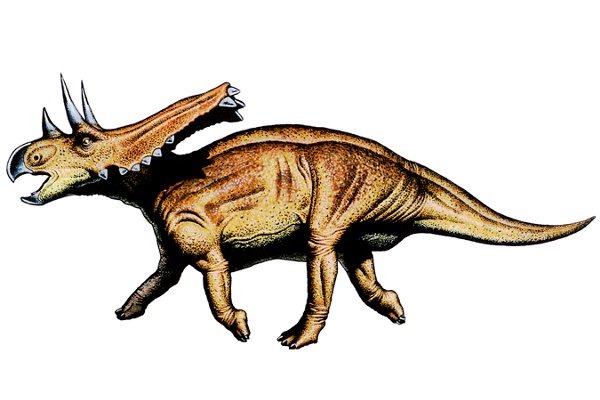
Illustration by Robert F Walters
Chasmosaurus belli
- Pronunciation:
- KAZ-mo_SORE-us, BELL-eye
- Meaning of name:
- Bell's open lizard
- Length:
- 17 feet (5 meters)
- Weight:
- Estimated 2 tons (1,800 kg)
- Diet:
- Plants
- Range:
- North America (Alberta)
- Age:
- Late Cretaceous, 76-73 million years ago
- What's real?:
- This mount is a cast of the original at the Canadian Museum of Nature.
- What is it?
- Chasmosaurus is a ceratopsian (horned dinosaur).
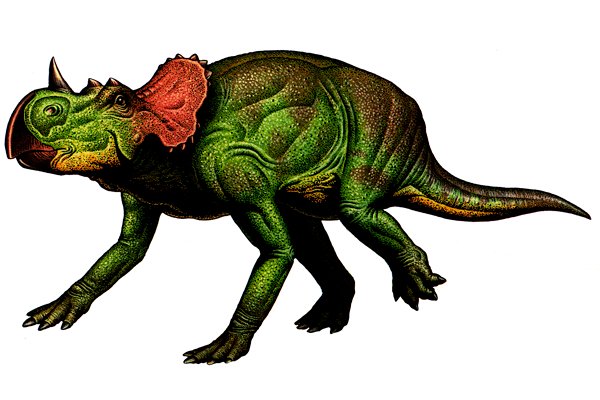
Illustration by Robert F Walters
Avaceratops lammersi
- Pronunciation:
- AY-va-SARE-ah-tops LAMM-urz-eye
- Meaning of name:
- Ava's horned face, of the Lammers
- Length:
- 7 feet (2 meters)
- Weight:
- Estimated 400 pounds (180 kg)
- Diet:
- Plants
- Range:
- North America (Montana)
- Age:
- Late Cretaceous, 76 million years ago
- What's real?:
- The skeleton is a cast. The original bones are kept in the Academy's research collection for study.
- What is it?
- Avaceratops is a ceratopsian or horned dinosaur.
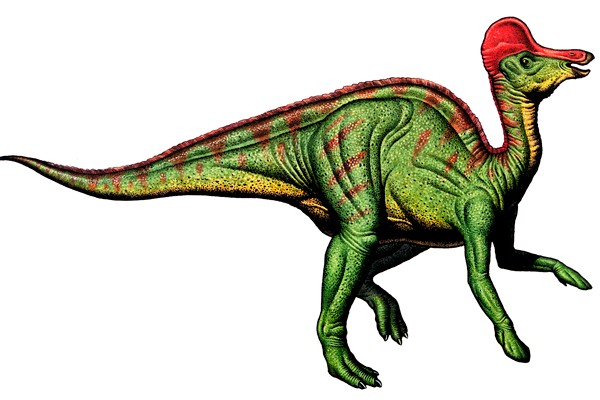
Illustration by Robert F Walters
Corythosaurus casuarius
- Pronunciation:
- core-ITH-oh_SORE-us, CASS-oo-WARE-ee-us
- Meaning of name:
- Helmeted lizard, like a cassowary bird
- Length:
- 30 feet (9 meters)
- Weight:
- Estimated 3 tons (2,700 kg)
- Diet:
- Plants
- Range:
- North America (Alberta)
- Age:
- Late Cretaceous, 76-73 million years ago
- What's real?:
- Most of this fossil skeleton is real. The skull is a cast of an original Corythosaurus skull from the Royal Ontario Museum in Toronto.
- What is it?
- Corythosaurus is a hadrosaur (or duckbill) dinosaur.

Illustration by Robert F Walters
Deinonychus antirrhopus
- Pronunciation:
- dye-NON-ick-us, ant-er-ROPE-us
- Meaning of name:
- Terrible claw, counterbalanced
- Length:
- 9.5 feet (3 meters)
- Weight:
- Estimated 175 pounds (80 kg)
- Diet:
- Meat
- Range:
- North America (Montana, Wyoming)
- Age:
- Early Cretaceous, 115-105 million years ago
- What's real?:
- This is a cast of the original fossil material at Yale University.
- What is it?
- Deinonychus is a theropod dinosaur.
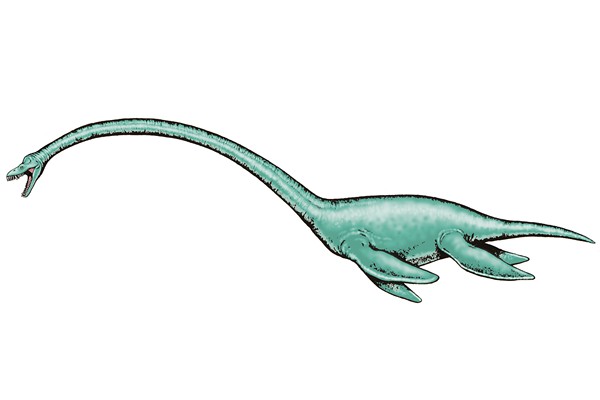
Illustration by Robert F Walters
Elasmosaurus platyurus
- Pronunciation:
- ee-LAZ-mow-SORE-us PLAT-ee-YOUR-us
- Meaning of name:
- thin-plated lizard with flat tail
- Length:
- 42 feet (13 meters)
- Weight:
- Estimated at 2.3 tons (2,100 kg)
- Diet:
- Meat
- Range:
- North America (Kansas)
- Age:
- Late Cretaceous, 82 million years ago
- What's real?:
- This mount is a cast. The original fossils are in the Academy's research collection for study.
- What is it?
- Elasmosaurus is not a dinosaur. It is a plesiosaur, a marine reptile.
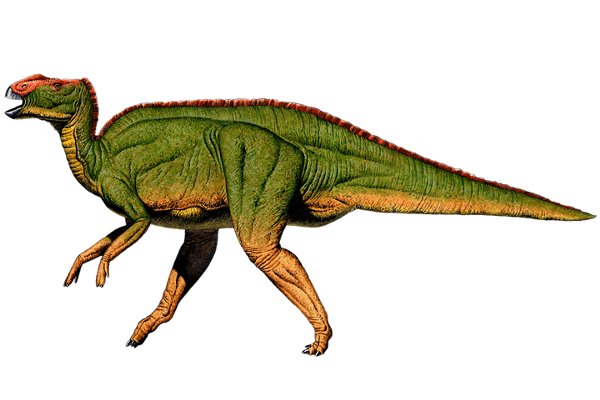
Illustration by Robert F Walters
Hadrosaurus foulkii
- Pronunciation:
- HAD-row_SORE-us, FOLK-eye
- Meaning of name:
- Foulke's bulky lizard
- Length:
- 23 feet (7 meters)
- Weight:
- Estimated 2.5 tons (3,200 kg)
- Diet:
- Plants
- Range:
- North America (New Jersey)
- Age:
- Late Cretaceous, 73 million years ago
- What's real?:
- The bones from this mount are cast from the original fossils, which are in the Academy's research collection for study.
- What is it?
- Hadrosaurus is a hadrosaur (or duckbill) dinosaur.
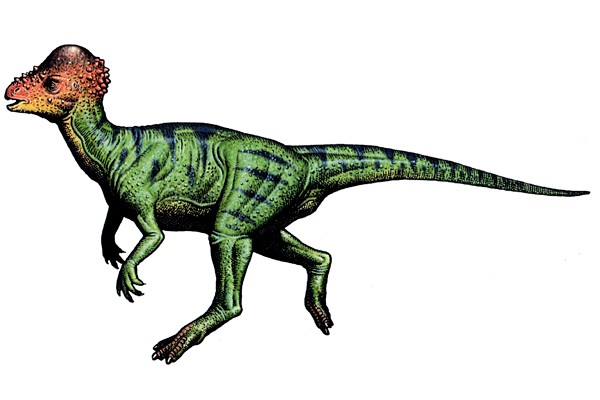
Illustration by Robert F Walters
Pachycephalosaurus wyomingensis
- Pronunciation:
- PASK-ee-SEFF-uh-low-SORE-us, wyy-OME-ing-EN-sis
- Meaning of name:
- Thick-headed lizard from Wyoming
- Length:
- 9 feet (3 meters)
- Weight:
- Estimated 250 pounds (115 kg)
- Diet:
- Plants
- Range:
- North America (Alberta, Montana, South Dakota, Wyoming)
- Age:
- Late Cretaceous, 68-65 million years ago
- What is it?
- Pachycephalosaurus belongs to a group of dinosaurs called pachycephalosaurs (domed dinosaurs), which are related to ceratopsians (horned dinosaurs).
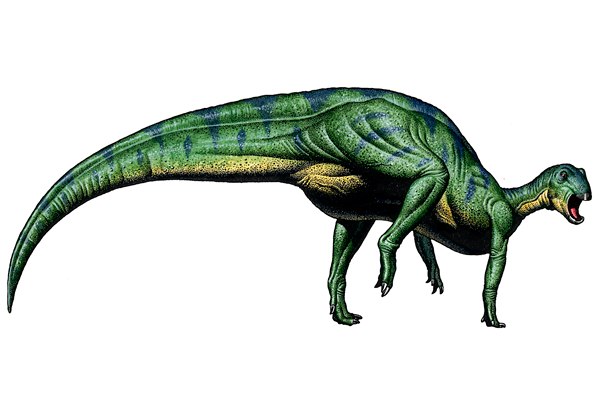
Illustration by Robert F Walters
Tenontosaurus tilletti
- Pronunciation:
- teh-NON-toe_SORE-us, TILL-et-eye
- Meaning of name:
- Tillett's tendon lizard
- Length:
- 23 feet (7 meters) for adults. The larger skeleton in the museum is a juvenile (13 feet or 4 meters). The smaller ones are young.
- Weight:
- Estimated 1,500 pounds (680 kg)
- Diet:
- Plants
- Range:
- North America (Montana, Utah, Wyoming)
- Age:
- Early Cretaceous, 115-105 million years ago
- What is it?
- Tenontosaurus is a dinosaur that is probably related to Iguanodon.
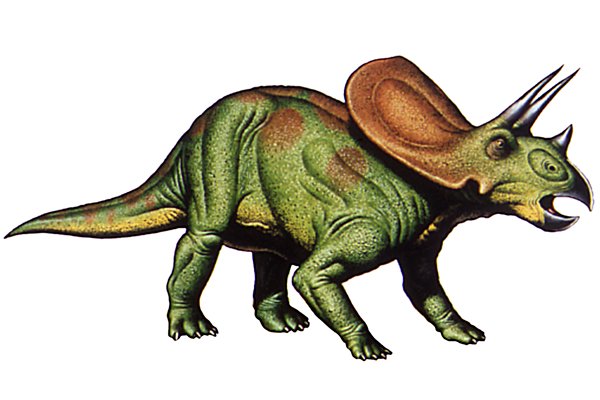
Illustration by Robert F Walters
Torosaurus latus
- Pronunciation:
- TORE-oh_SORE-us, LATT-us
- Meaning of name:
- Wide perforated lizard
- Length:
- 25 feet (7.5 meters)
- Weight:
- Estimated 6 tons (5,400 kg)
- Diet:
- Plants
- Range:
- North America (Wyoming, Montana, Saskatchewan)
- Age:
- Late Cretaceous, 68-65 million years ago
- What's real?:
- The skull is made up of real fossil but the missing parts are made of plaster.
- What is it?
- Torosaurus is a ceratopsian (horned dinosaur). Recent research by Jack Horner and his colleagues indicates that Torosaurus latus is not a true species. Instead, these fossils are probably from older individuals of Triceratops horridus.
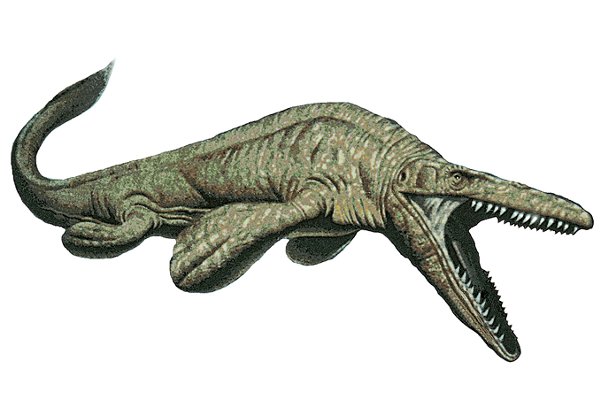
Illustration by Robert F Walters
Tylosaurus prorigor
- Pronunciation:
- TIE-low-SORE-us pro-RIG-or
- Meaning of name:
- Knot lizard, stiff in front
- Length:
- 43 feet (13 meters)
- Weight:
- Estimated 2 tons (1,800 kg)
- Diet:
- Fish, ammonites, other marine reptiles
- Range:
- North America (Kansas)
- Age:
- Late Cretaceous, 85-78 million years ago
- What's real?:
- The skeleton is a cast of the original at the Kansas University Museum of Natural History
- What is it?
- Tylosaurus is a mosasaur and not a dinosaur. It's related to monitor lizards.
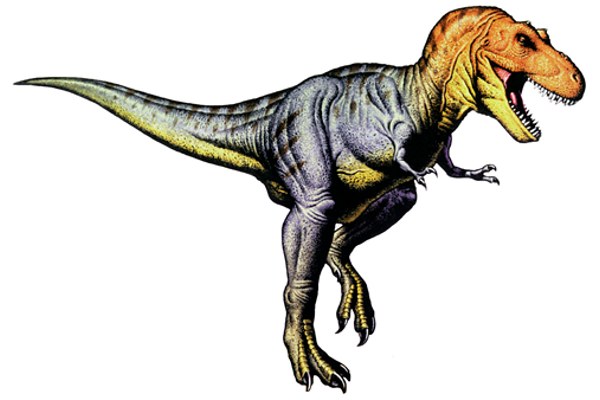
Illustration by Robert F Walters
Tyrannosaurus rex
- Pronunciation:
- tie-RAN-oh-SORE-us REX
- Meaning of name:
- tyrant lizard, king
- Length:
- 35-40 feet (10-12 meters)
- Weight:
- Estimated 6 tons (5,500 kg)
- Diet:
- Meat
- Range:
- North America (Alberta, Colorado, Montana, New Mexico, Saskatchewan, South Dakota and Wyoming)
- Age:
- Late Cretaceous, 68-65 million years ago
- What's real?:
- The skeleton and skulls are casts. The original fossils are in the American Museum of Natural History in New York.
- What is it?
- Tyrannosaurus is a theropod dinosaur.